Choosing energy-saving lamps: a comparative overview of 3 types of energy-efficient light bulbs
Energy saving is a large-scale task for which the latest technologies are applied. Increasing electricity consumption is forcing users to use energy-saving lamps - innovative lighting technology has increased efficiency with reduced energy consumption.
The market offers a wide range of “housekeepers,” but it's easy to get confused in such a variety, agree? We will help you make the right choice.
The article provides a detailed overview of three types of lamps with a description of their characteristics and application features, the parameters that are definitely worth considering when choosing energy-saving lamps are indicated.
The content of the article:
Energy Efficiency Classification
Determining the economic effect is possible by comparing two samples. Incandescent lamps, the most inefficient of modern light sources, were chosen as an object of analogy. This is what served as the basis for the promotion of the advertising slogan “energy-saving light bulbs”.
Electric lamps with high light output and low power consumption are divided into three main types: LED, fluorescent and halogen.
Moreover, each category differs not only in structural features, but also in the quality of economy:
- luminescent able to save up to 80% of electricity;
- LED – 80-90%;
- halogen – 30-50%.
Economic indicators in them are achieved due to high efficiency. Most of their power is aimed at reproducing the light flux, and heat transfer and other costly processes are minimized.
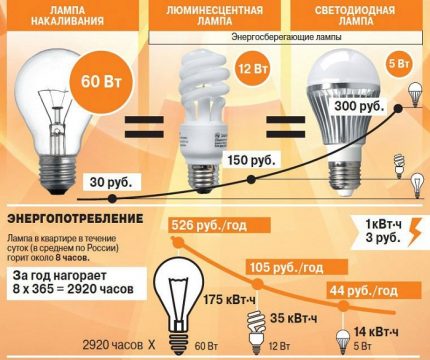
Nevertheless, luminescent lighting equipment managed to gain the most popularity, which was used not only in everyday life, but also in various spheres of life: offices, warehouses, etc. However, the item of expenses for their disposal forces entrepreneurs to introduce a newer form - LED analogues.
Fluorescent Discharge Lamps
Fluorescent lamps used in everyday life are called compact (CFL). As a rule, they are made in the form of an arcuate spiral and are traditionally equipped with a screw base. They can be screwed into a standard cartridge, instead of an uneconomical analogue.
Basic structural elements compact fluorescent tubes:
- gas discharge flask;
- choke;
- diode bridge;
- fuse;
- filter capacitor.
The glass flask is filled with an inert gas (argon or neon), mixed with mercury vapor. Mercury pressure is subordinate to the temperature indices of the CFL walls and at a standard operating temperature of 40 ° C it will be in the range of 0.13-1.3 N / m2.
Inside the lamp is covered with a layer of phosphor, which includes calcium halophosphate or antimony with manganese. By changing the ratio of the so-called light activators, manufacturers were able to achieve various color parameters of the glow.
Here are located tungsten spiral electrodes connected via a ballast to the power supply. To increase the emission, the contacts are treated with an oxide composition.
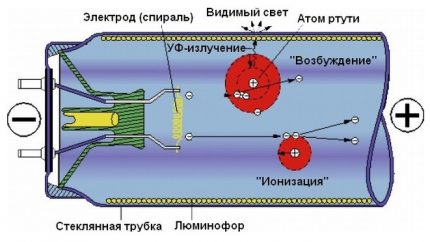
The technology used to reproduce light in them is significantly different from other analogues. Under the influence of an electric field applied to the contacts, the lamp produces a gas discharge.
It pierces the inert atmosphere of the flask, resulting in the formation of ultraviolet radiation. However, this spectrum is invisible to humans, so the phosphor further absorbs it, converting it into a standard visible glow.

Gas-discharge devices are presented both in open form and complete with a diffuser.
They are available with socles of various modifications:
- E27 - standard socket;
- E14 - type minion;
- E40 - for a large seat;
- G23, 2G7, G53, 2D - decorative appearance of devices: spotlights, lights, etc.
Depending on the quality of the constituent elements, the uptime guaranteed by the manufacturer varies from 3,000 to 15,000 hours.
Installation is greatly simplified by placing all the elements in one inseparable housing, including the ballast.
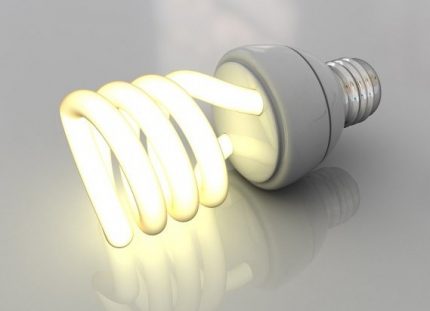
If we compare the luminescent with an incandescent lamp, it can be noted that the positive characteristics of the first substantially prevail:
- durability - due to application Electronic ballastscharacterized by resistance to voltage drops, the life of the device increases significantly up to 20,000 hours;
- heat transfer coefficient reducedtherefore they are allowed to be mounted in any types of fixtures without risk of an overheat;
- color temperature spectrum variabilitythat are successfully used in the design of the room.
Since the device uses standardized elements, provided that the gas cylinder is kept tight, it is possible to replace failed parts.
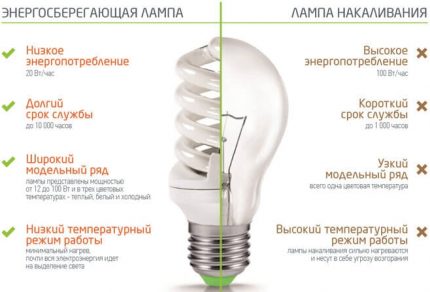
Thanks to leading developments, ELL shortcomings are being tried to minimize, but at the moment they are still present:
- LL service life is limited.
- The use of mercury vapors, which are harmful not only for humans, but also for the environment, if the flask depressurizes.
- Due to the presence of the previous paragraph, it is required to accept product disposal measures. For large enterprises - this is an additional expense item.
- The fragility of the glass body.
Uncontrolled deliveries of low-quality products to the markets and the mass distribution of such products entails a loss of customer confidence. More than half of the bulbs of base Chinese production do not comply with GOST.
Features of halogen lamps
This is an improved version of standard incandescent bulbs containing halogen pairs in their design. The filament body in these products is made of tungsten filaments located as close as possible to the cartridge of the device. To give them spiral shapes, they are twisted and fixed by means of electrodes and holders.
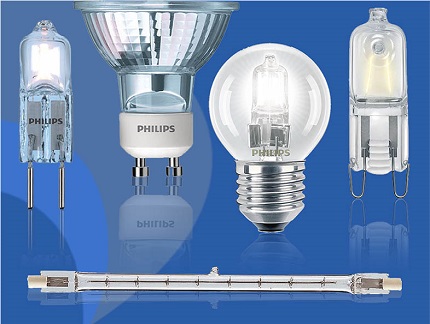
The algorithm of the device’s operation is as follows: tungsten atoms leave the red-hot wire and collide with halogen vapors in a flask and connect with them. But high temperature gives no other way for the development of the chemical process, except for the decomposition of the compound - the tungsten atoms again return to the wire spiral.
To date, methylene bromide or methyl are used as the halogen composition. However, work continues on the selection of effective volatile halogen compounds. Since all the elements are enclosed in a quartz flask, ultraviolet rays can pass through such a material, therefore measures are taken to block them.
In network products, the lamp is additionally placed in a shell of glass. Partial filtering of harmful radiation is achieved by applying a special composition to the flask. These lamps are marked UV Stop or UV block.
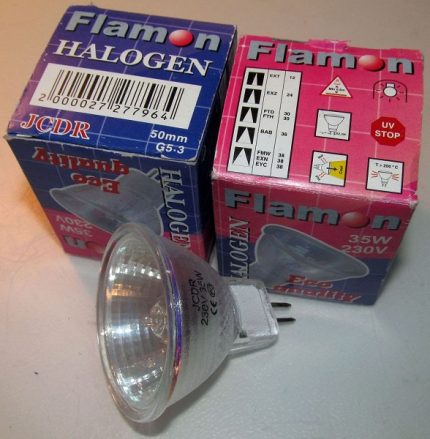
The service life of such bulbs is determined by the moment of depletion of tungsten filaments. Thanks to the use of the halogen cycle, manufacturers achieve an increase in light output while maintaining an identical service life, as in incandescent lamps - 1000 hours.
Or they extend the operational period to 4000-5000 hours with the same light parameters.
The operation of such luminaires is designed for low mains voltage - 6, 12 or 24 V, so they are used only in conjunction with halogen lamp transformer.
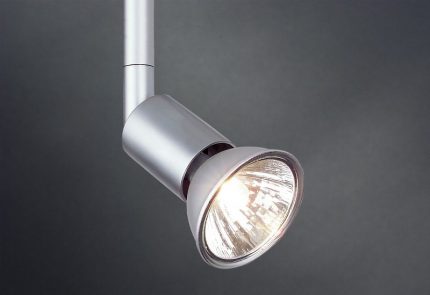
The most powerful example is metal halide lamp directional light. This lighting option is suitable for rooms where objects with increased sensitivity to heat are located, because of which they deteriorate or collapse.
In most cases, they are used to illuminate shop windows. The intense white color of the glow with a color temperature of 3200 K successfully emphasizes the brilliant elements and color variety of the highlighted products.
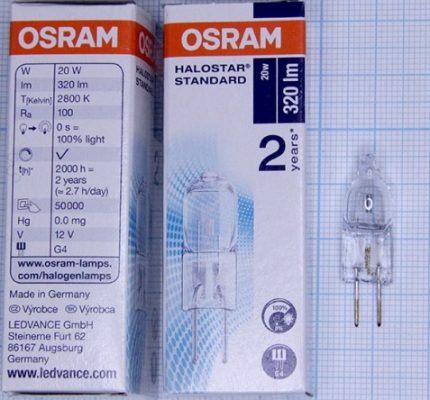
The most compact design for capsule models.The process of their manufacture is based on low-pressure technology, so they can be used in open luminaires. Only two modifications are available - with longitudinal or transverse placement of tungsten filament.
The main advantage over all glass analogues is the use of a quartz flask. The design is characterized by increased strength to mechanical stress and a high degree of heat resistance.
Thanks to this, it is possible to fill the lamp with xenon under high pressure, which ensures high brightness and light output.

Additionally, we note such advantages:
- time stable light flow;
- compact sizes;
- operate without a transformer, with the exception of low voltage, in networks with a high voltage of 220-240 V;
- wide angle of light scattering, without sharp restrictions into a narrow beam;
- throughout the entire service life, the brightness is not lost;
- it is possible to adjust the light intensity;
- high level of safety - low-voltage models can be used in rooms with high humidity and in fixtures without a protective glass.
In addition to the positive aspects, halogens also have negative characteristics, which include excessive heating of the flask. In some models, the temperature reaches 500 ° C. For this reason, the installation of lighting should be carried out with a certain distance from objects - other light sources and the ceiling.
As well as halogen products, susceptibility to voltage drops is characteristic, which is a significant minus.
The linear type models deserved the most complaints: they cannot be operated for a long time in a vertical or inclined position. As a result, halogen substances and gas are separated and the device ceases to function.

Separately, it is worth noting that you can not touch the lamp with your hands, because spots remain on it. They screw it in, having previously wrapped it in a piece of rags, or put on gloves.
For more information on choosing a halogen lamp, see this article.
LED lamps
Due to the low energy consumption, initially, LED crystals were used exclusively to indicate various processes in electronic devices. But over time, they began to improve, using super-bright LED elements, allowing them to be used in backlight circuits in almost all areas of activity.
The device of such light sources consists of several elements - a driver, LEDs and a strap made of getinaks. Details are enclosed in a housing shaped like “corn,” an elongated bulb, or a spot type.
All of them are made of polycarbonate. This design eliminated the main problem - the likelihood of mechanical damage.
Due to the fact that the device already has ballast, the lamp is connected directly to the power supply without ballasts.
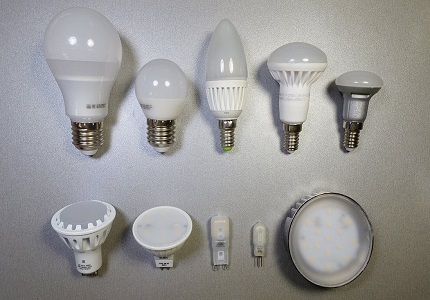
The narrow focus of the diodes allows you to combine them into small or large groups.
Depending on the intended installation location, the lamps are divided into:
- automobile;
- industrial;
- phytolamps for plants (presented in a linear type);
- street floodlights;
- household and office.
Devices linear type used in various conditions.For illumination in landscape design, it is advisable to choose devices with a high degree of protection - IP65, IP67.
They can be either tubular, or more powerful, represented by searchlights. Suitable for rooms with a standard climate - IP20.
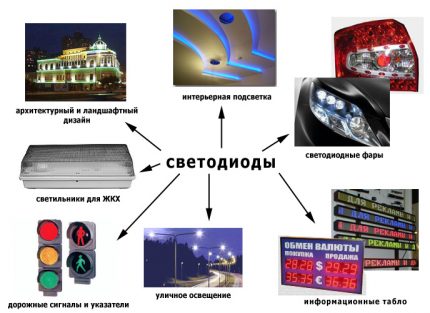
The overview form factor has the greatest number of positive characteristics compared to all the sources described above:
- 220 V mains supply without ballasts;
- the lowest energy consumption of all presented species;
- does not require special disposal methods;
- does not radiate heat;
- scattering angle reaches 230 degrees;
- lack of a pulsating effect;
- high degree of light transmission up to 120 lm / W;
- service life of 50,000-100,000 hours;
- unbreakable case material;
- resistance to temperature extremes and other negative factors.
The only drawback of this modification is the high price category. However, with a greater degree of probability, future developments will help to neutralize this minus.
On our site there is a series of articles devoted to the selection of LED lamps, we recommend that you read:
- LED lamps for the home: which diode bulbs are better, LED lamp manufacturers overview
- Characteristics of LED lamps: color temperature, power, light and others
- Dimmable LED bulbs: selection tips, an overview of the best manufacturers
Rules for choosing energy-saving lamps
Incandescent bulbs have been in use for such a long time that when choosing an economical replacement, we focus solely on the power indicator. For a better understanding, many manufacturers directly on the packaging indicate the equivalent power compared to the luminous flux of a conventional vacuum lamp.
For clarity, it is worth noting that power and light flow are different indicators. The first value is measured in watts, the second in lumens. For example, a 40 W incandescent light emits light at 470-500 lm, 60 W - 700-850 lm, 75 W - 900-1200 lm.
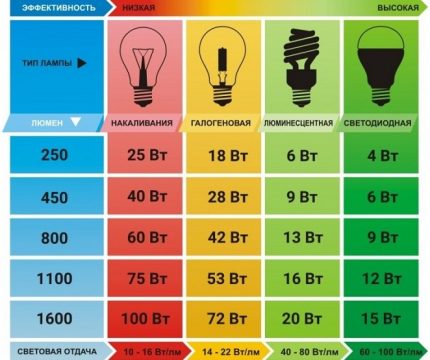
It is the ratio of these two factors - power and light flow - that allows us to judge the economical performance of the device. The total value is measured in lm / W.
Here is another example: standard lighting technology for 1 W of consumed electricity gives 10-15 lm of light. Halogen - 15-20 lm / W, luminescent - 40-80 lm / W and LED leaders - 60-90 lm / W.
However, this is not the only aspect requiring attention.
It is important to pay attention to the following characteristics:
- Colour temperature. If you take lamps of identical power, but of different modifications, the color of their radiation can be different. This value is measured in kelvins. The choice color temperature can be made in the range of 2700-6500 K. The lower the value, the warmer (yellow) the light.
- Color rendering index. An indicator of correct color rendering is sunlight - CRI = 100. Artificial lighting has not yet reached such parameters. Here it is necessary to build on the optimal CRI = 80 or more.
- Service life. Manufacturers indicate this value in hours. However, such marking is not convenient for everyone. Imagine it in years: halogen - 2 years, luminescent - 5 years, LED - up to 12 years.
- Cartridge type. The form lamp base It is selected for a specific model of the lamp. The standard version of an incandescent lamp is E27.
When choosing the shape of the bulb, the exclusively aesthetic side plays a role here. However, it is worth considering that too large a lamp may not fit in the glass frame of the lamp.
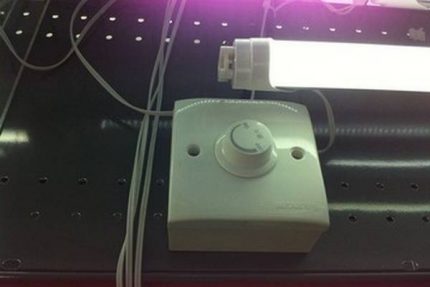
To meet all expectations, it is worth paying attention to manufacturers whose products have already managed to positively establish themselves: Philips, OSRAM, GE, Ecola. These companies offer a warranty period of 2-3 years for their products.
Conclusions and useful video on the topic
The video shows which light sources are the most economical:
Review and testing of Feron LED lamps:
Despite the fact that you can still find incandescent lamps in the markets, energy-efficient analogues will soon completely displace them from the shelves. If you replace all the appliances in the fixtures with them, after two years the money spent will fully pay off. What follows is full savings.
Share your experience with energy-saving lamps with your readers. Tell us which fixtures you have chosen, are you satisfied with the purchase. Please leave comments on the article, ask questions and participate in discussions. The contact form is located below.

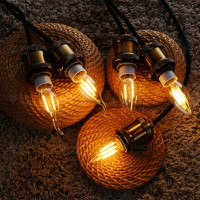 LED lamps with e14 socket: a comparative overview of the best models on the market
LED lamps with e14 socket: a comparative overview of the best models on the market  G4 halogen lamps: features, pros and cons + rating of light bulb manufacturers
G4 halogen lamps: features, pros and cons + rating of light bulb manufacturers 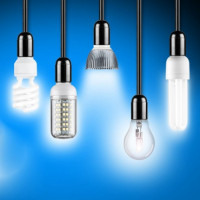 What types of bulbs exist: an overview of the main types of lamps + rules for choosing the best
What types of bulbs exist: an overview of the main types of lamps + rules for choosing the best 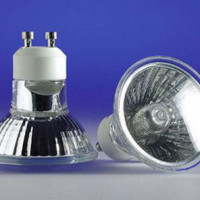 12 Volt Halogen Lamps: Overview, Features + Overview of Leading Manufacturers
12 Volt Halogen Lamps: Overview, Features + Overview of Leading Manufacturers  Smart lamp: features of use, types, device + overview of the best models of bulbs
Smart lamp: features of use, types, device + overview of the best models of bulbs 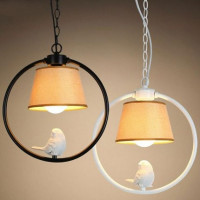 220V LED lamps: characteristics, marking, selection criteria + review of the best brands
220V LED lamps: characteristics, marking, selection criteria + review of the best brands  How much does it cost to connect gas to a private house: the price of organizing gas supply
How much does it cost to connect gas to a private house: the price of organizing gas supply  The best washing machines with dryer: model rating and customer tips
The best washing machines with dryer: model rating and customer tips  What is the color temperature of light and the nuances of choosing the temperature of the lamps to suit your needs
What is the color temperature of light and the nuances of choosing the temperature of the lamps to suit your needs  Replacement of a geyser in an apartment: replacement paperwork + basic norms and requirements
Replacement of a geyser in an apartment: replacement paperwork + basic norms and requirements
I almost did not use halogen lamps, I got more and more used to the classic energy-saving versions of the standard socket - the 27th basement of various capacities of the white and blue light spectrum. Due to its diversity of color spectrum, fluorescent lamps perfectly beat the interior of the room, emphasizing the unique style.
Despite the fact that LED bulbs are quite durable, yesterday I still burned out one. From the moment I installed it in the chandelier, something has passed about two years. And here's the problem: where to dispose of it? Can it be thrown into an ordinary urn or not? Does it contain hazardous substances? I handed over fluorescent lamps to special points of reception, and with these how?
Feel free to throw diode lamps in the trash. This is not luminescent to you, there is nothing harmful in them. Inside there is only a driver (read the electronic control board) and diodes on this very board. And as far as I know, the manufacturer of led lamps gives them a guarantee is not small. And they kind of can be exchanged in case of early failure. Naturally, no one is doing this with us, but it's worth a try.